Analysis of the Healthcare Economy of the USA: Reforms and Policies
VerifiedAdded on 2023/06/03
|5
|819
|265
Report
AI Summary
This report provides an analysis of the healthcare economy of the United States, examining the rising healthcare expenditures and the need for reform. The report focuses on two primary areas for cost control: cuts in Medicare and Medicaid programs, and malpractice reforms. It discusses the negative implications of Medicare and Medicaid, such as prescription abuses, high drug prices, and excessive hospital payments, proposing budget cuts in these areas to improve efficiency. Additionally, the report addresses the issue of defensive medicine and proposes reforms to reduce unnecessary procedures and tests. The conclusion emphasizes that a combination of these policies is crucial for achieving cost-control targets in the US healthcare system.
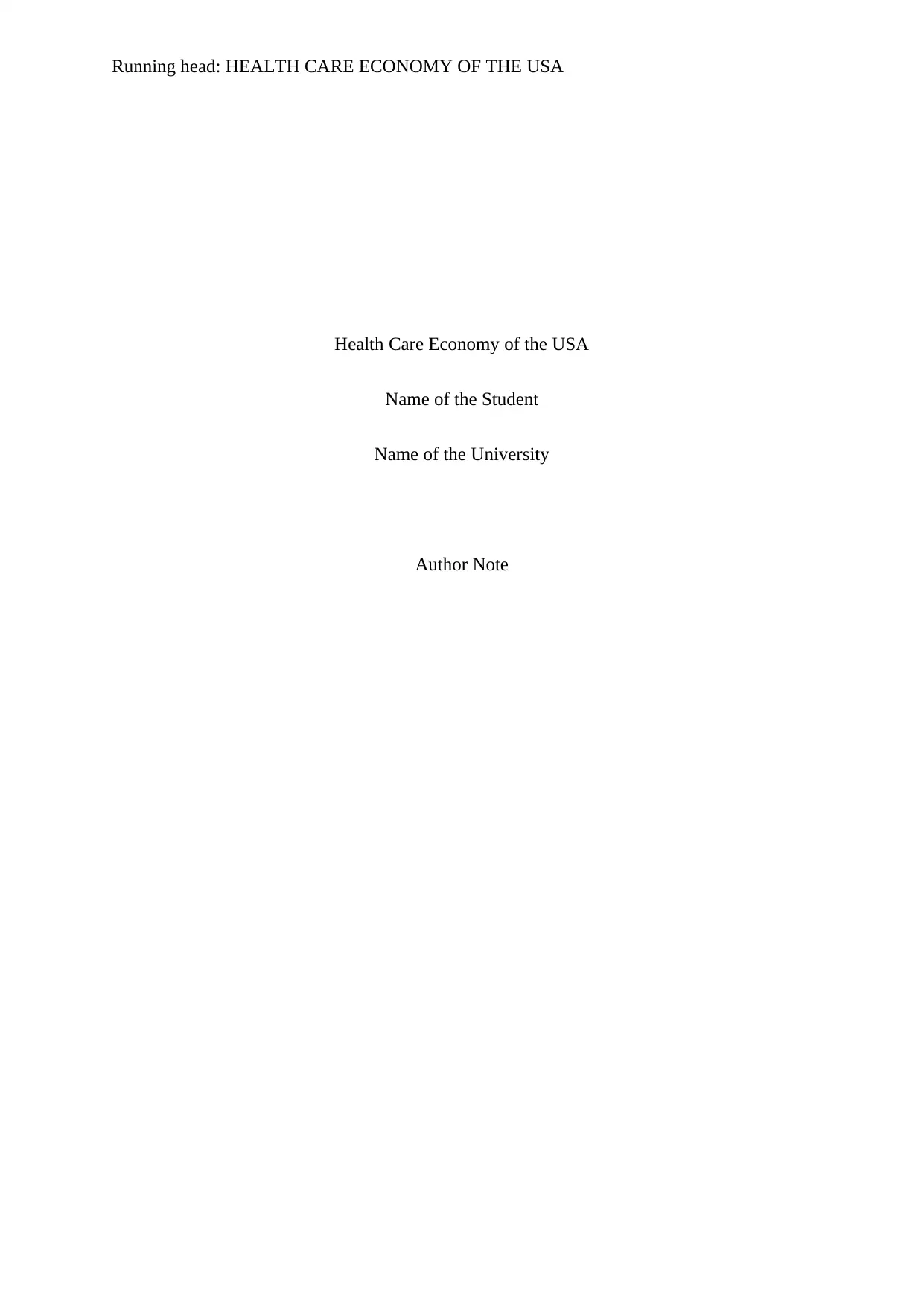
Running head: HEALTH CARE ECONOMY OF THE USA
Health Care Economy of the USA
Name of the Student
Name of the University
Author Note
Health Care Economy of the USA
Name of the Student
Name of the University
Author Note
Paraphrase This Document
Need a fresh take? Get an instant paraphrase of this document with our AI Paraphraser
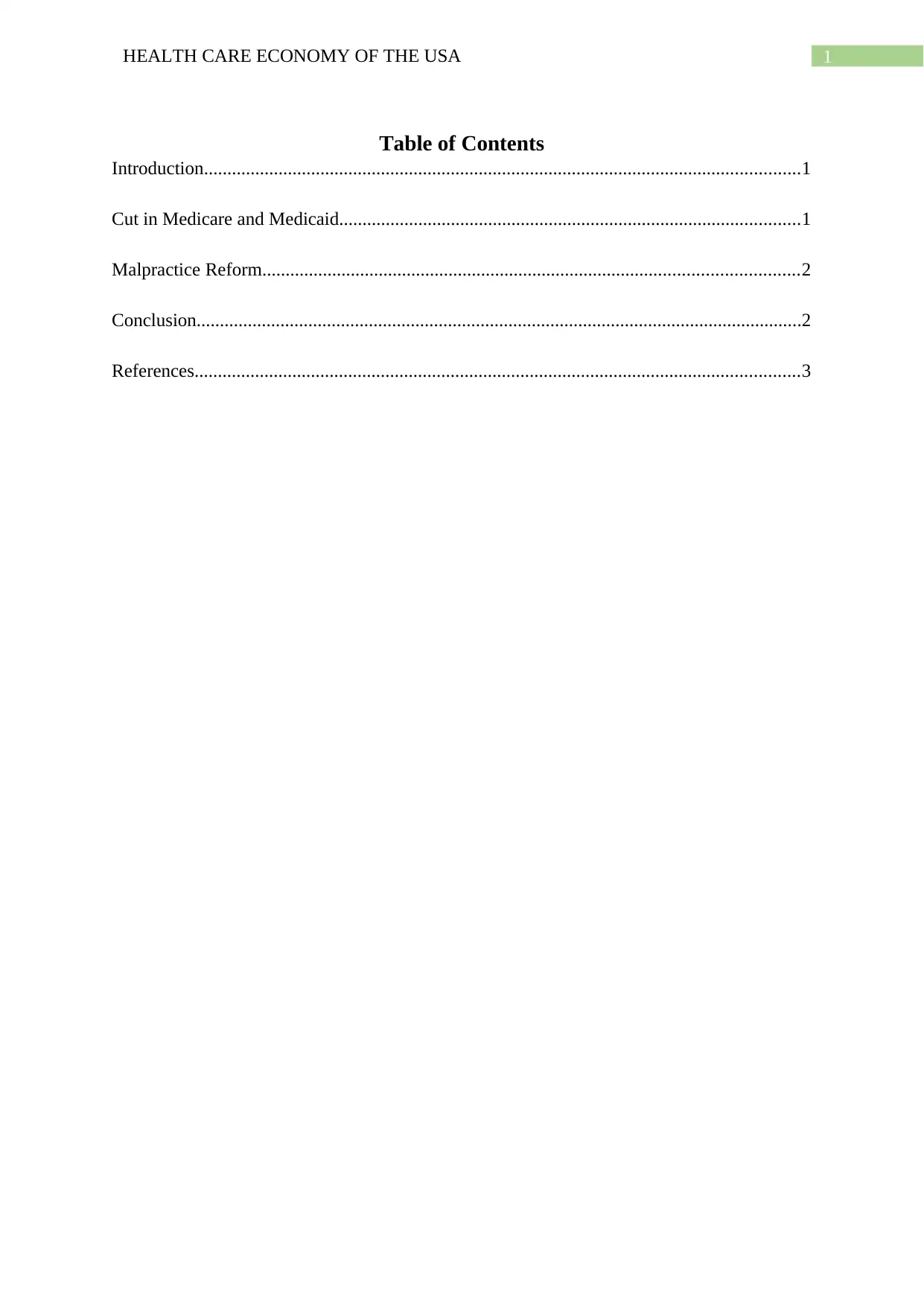
1HEALTH CARE ECONOMY OF THE USA
Table of Contents
Introduction................................................................................................................................1
Cut in Medicare and Medicaid...................................................................................................1
Malpractice Reform...................................................................................................................2
Conclusion..................................................................................................................................2
References..................................................................................................................................3
Table of Contents
Introduction................................................................................................................................1
Cut in Medicare and Medicaid...................................................................................................1
Malpractice Reform...................................................................................................................2
Conclusion..................................................................................................................................2
References..................................................................................................................................3
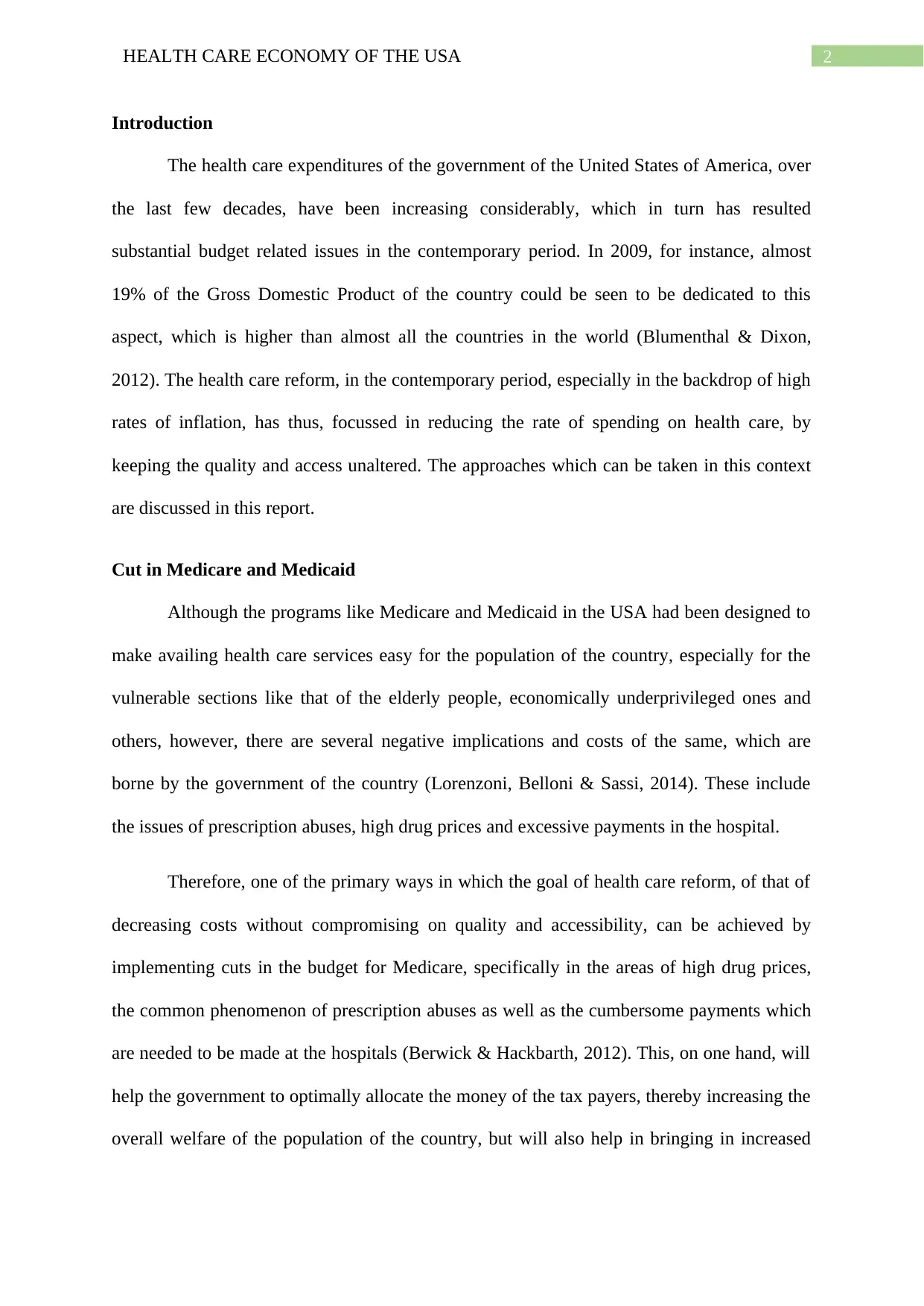
2HEALTH CARE ECONOMY OF THE USA
Introduction
The health care expenditures of the government of the United States of America, over
the last few decades, have been increasing considerably, which in turn has resulted
substantial budget related issues in the contemporary period. In 2009, for instance, almost
19% of the Gross Domestic Product of the country could be seen to be dedicated to this
aspect, which is higher than almost all the countries in the world (Blumenthal & Dixon,
2012). The health care reform, in the contemporary period, especially in the backdrop of high
rates of inflation, has thus, focussed in reducing the rate of spending on health care, by
keeping the quality and access unaltered. The approaches which can be taken in this context
are discussed in this report.
Cut in Medicare and Medicaid
Although the programs like Medicare and Medicaid in the USA had been designed to
make availing health care services easy for the population of the country, especially for the
vulnerable sections like that of the elderly people, economically underprivileged ones and
others, however, there are several negative implications and costs of the same, which are
borne by the government of the country (Lorenzoni, Belloni & Sassi, 2014). These include
the issues of prescription abuses, high drug prices and excessive payments in the hospital.
Therefore, one of the primary ways in which the goal of health care reform, of that of
decreasing costs without compromising on quality and accessibility, can be achieved by
implementing cuts in the budget for Medicare, specifically in the areas of high drug prices,
the common phenomenon of prescription abuses as well as the cumbersome payments which
are needed to be made at the hospitals (Berwick & Hackbarth, 2012). This, on one hand, will
help the government to optimally allocate the money of the tax payers, thereby increasing the
overall welfare of the population of the country, but will also help in bringing in increased
Introduction
The health care expenditures of the government of the United States of America, over
the last few decades, have been increasing considerably, which in turn has resulted
substantial budget related issues in the contemporary period. In 2009, for instance, almost
19% of the Gross Domestic Product of the country could be seen to be dedicated to this
aspect, which is higher than almost all the countries in the world (Blumenthal & Dixon,
2012). The health care reform, in the contemporary period, especially in the backdrop of high
rates of inflation, has thus, focussed in reducing the rate of spending on health care, by
keeping the quality and access unaltered. The approaches which can be taken in this context
are discussed in this report.
Cut in Medicare and Medicaid
Although the programs like Medicare and Medicaid in the USA had been designed to
make availing health care services easy for the population of the country, especially for the
vulnerable sections like that of the elderly people, economically underprivileged ones and
others, however, there are several negative implications and costs of the same, which are
borne by the government of the country (Lorenzoni, Belloni & Sassi, 2014). These include
the issues of prescription abuses, high drug prices and excessive payments in the hospital.
Therefore, one of the primary ways in which the goal of health care reform, of that of
decreasing costs without compromising on quality and accessibility, can be achieved by
implementing cuts in the budget for Medicare, specifically in the areas of high drug prices,
the common phenomenon of prescription abuses as well as the cumbersome payments which
are needed to be made at the hospitals (Berwick & Hackbarth, 2012). This, on one hand, will
help the government to optimally allocate the money of the tax payers, thereby increasing the
overall welfare of the population of the country, but will also help in bringing in increased
⊘ This is a preview!⊘
Do you want full access?
Subscribe today to unlock all pages.

Trusted by 1+ million students worldwide
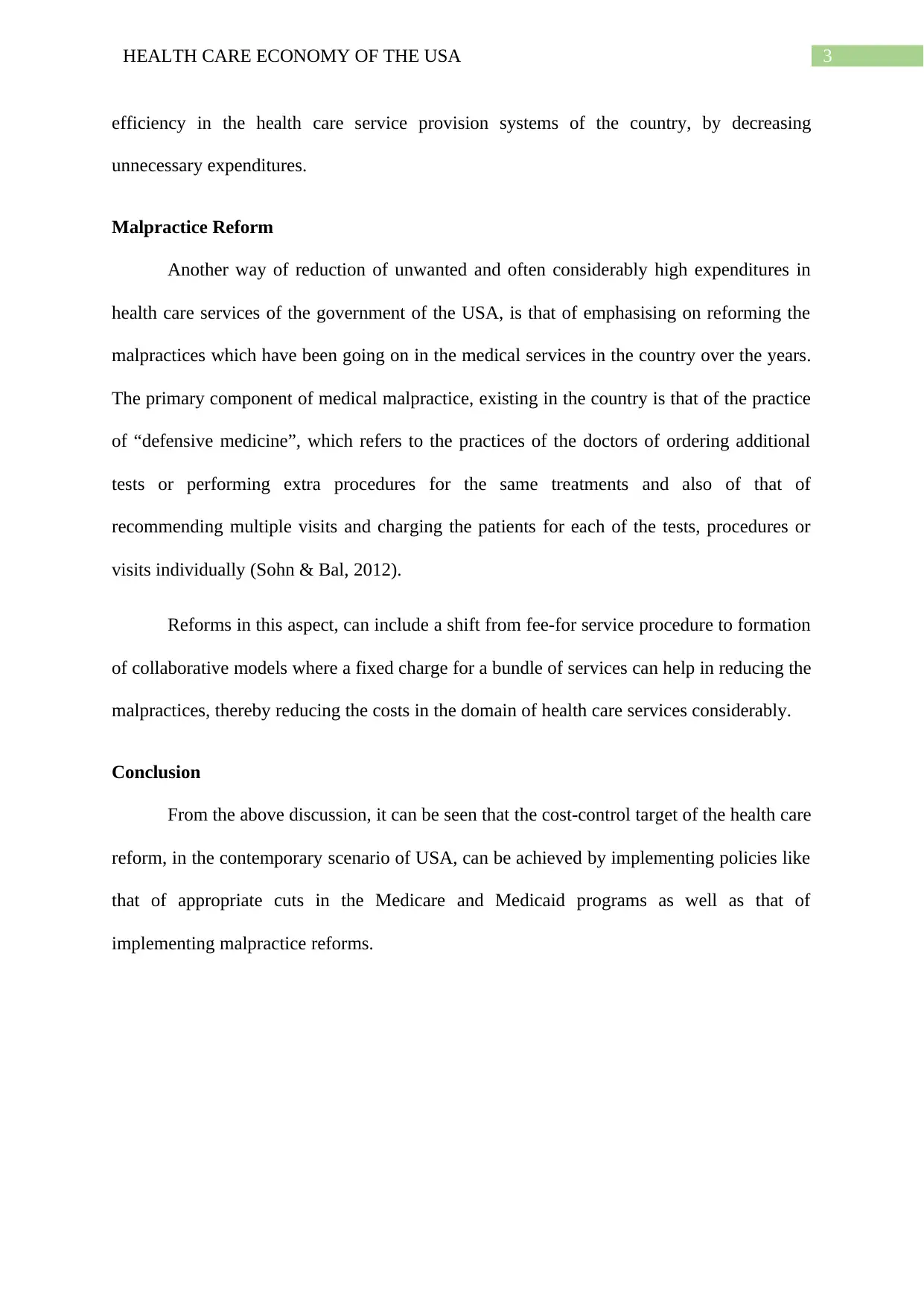
3HEALTH CARE ECONOMY OF THE USA
efficiency in the health care service provision systems of the country, by decreasing
unnecessary expenditures.
Malpractice Reform
Another way of reduction of unwanted and often considerably high expenditures in
health care services of the government of the USA, is that of emphasising on reforming the
malpractices which have been going on in the medical services in the country over the years.
The primary component of medical malpractice, existing in the country is that of the practice
of “defensive medicine”, which refers to the practices of the doctors of ordering additional
tests or performing extra procedures for the same treatments and also of that of
recommending multiple visits and charging the patients for each of the tests, procedures or
visits individually (Sohn & Bal, 2012).
Reforms in this aspect, can include a shift from fee-for service procedure to formation
of collaborative models where a fixed charge for a bundle of services can help in reducing the
malpractices, thereby reducing the costs in the domain of health care services considerably.
Conclusion
From the above discussion, it can be seen that the cost-control target of the health care
reform, in the contemporary scenario of USA, can be achieved by implementing policies like
that of appropriate cuts in the Medicare and Medicaid programs as well as that of
implementing malpractice reforms.
efficiency in the health care service provision systems of the country, by decreasing
unnecessary expenditures.
Malpractice Reform
Another way of reduction of unwanted and often considerably high expenditures in
health care services of the government of the USA, is that of emphasising on reforming the
malpractices which have been going on in the medical services in the country over the years.
The primary component of medical malpractice, existing in the country is that of the practice
of “defensive medicine”, which refers to the practices of the doctors of ordering additional
tests or performing extra procedures for the same treatments and also of that of
recommending multiple visits and charging the patients for each of the tests, procedures or
visits individually (Sohn & Bal, 2012).
Reforms in this aspect, can include a shift from fee-for service procedure to formation
of collaborative models where a fixed charge for a bundle of services can help in reducing the
malpractices, thereby reducing the costs in the domain of health care services considerably.
Conclusion
From the above discussion, it can be seen that the cost-control target of the health care
reform, in the contemporary scenario of USA, can be achieved by implementing policies like
that of appropriate cuts in the Medicare and Medicaid programs as well as that of
implementing malpractice reforms.
Paraphrase This Document
Need a fresh take? Get an instant paraphrase of this document with our AI Paraphraser
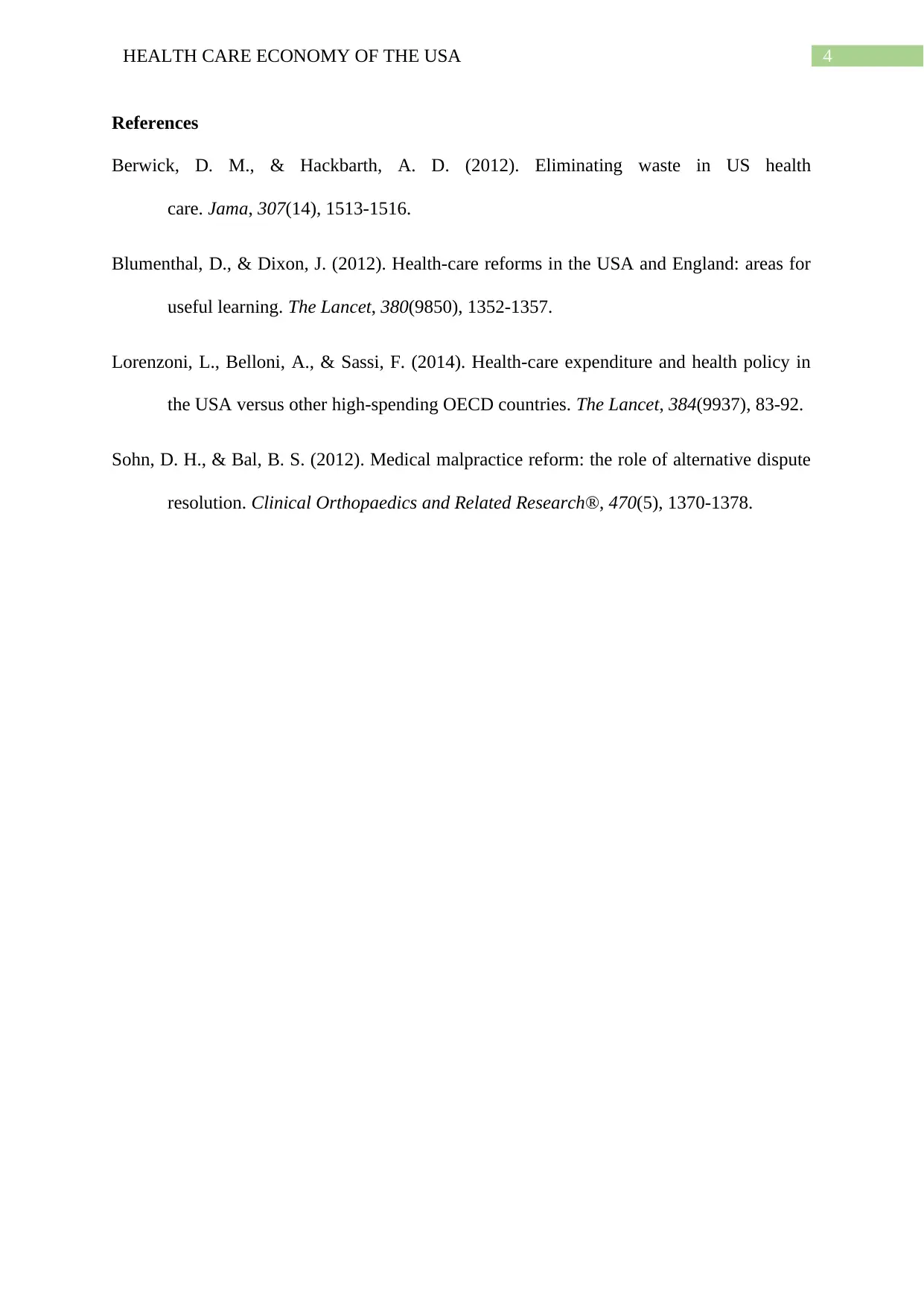
4HEALTH CARE ECONOMY OF THE USA
References
Berwick, D. M., & Hackbarth, A. D. (2012). Eliminating waste in US health
care. Jama, 307(14), 1513-1516.
Blumenthal, D., & Dixon, J. (2012). Health-care reforms in the USA and England: areas for
useful learning. The Lancet, 380(9850), 1352-1357.
Lorenzoni, L., Belloni, A., & Sassi, F. (2014). Health-care expenditure and health policy in
the USA versus other high-spending OECD countries. The Lancet, 384(9937), 83-92.
Sohn, D. H., & Bal, B. S. (2012). Medical malpractice reform: the role of alternative dispute
resolution. Clinical Orthopaedics and Related Research®, 470(5), 1370-1378.
References
Berwick, D. M., & Hackbarth, A. D. (2012). Eliminating waste in US health
care. Jama, 307(14), 1513-1516.
Blumenthal, D., & Dixon, J. (2012). Health-care reforms in the USA and England: areas for
useful learning. The Lancet, 380(9850), 1352-1357.
Lorenzoni, L., Belloni, A., & Sassi, F. (2014). Health-care expenditure and health policy in
the USA versus other high-spending OECD countries. The Lancet, 384(9937), 83-92.
Sohn, D. H., & Bal, B. S. (2012). Medical malpractice reform: the role of alternative dispute
resolution. Clinical Orthopaedics and Related Research®, 470(5), 1370-1378.
1 out of 5
Related Documents
Your All-in-One AI-Powered Toolkit for Academic Success.
+13062052269
info@desklib.com
Available 24*7 on WhatsApp / Email
![[object Object]](/_next/static/media/star-bottom.7253800d.svg)
Unlock your academic potential
Copyright © 2020–2025 A2Z Services. All Rights Reserved. Developed and managed by ZUCOL.





